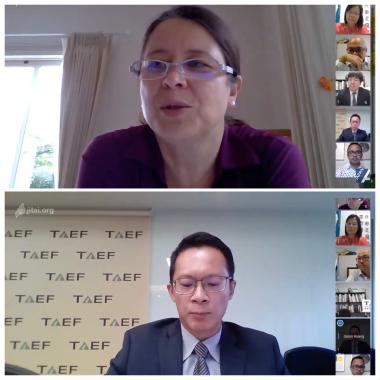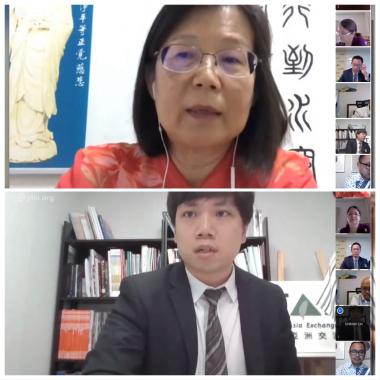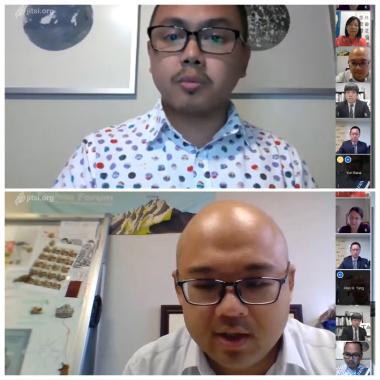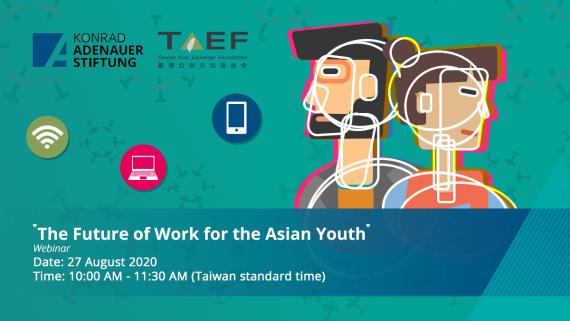Webinar Report
The Future of Work for the Asian Youth webinar series, jointly organized by the Konrad-Adenauer-Stiftung (KAS) Japan’s Social and Economic Governance in Asia (SOPAS) and the Taiwan-Asia Exchange Foundation (TAEF) finally launched on August 27, 2020, with a seminar that focused on Taiwan. The session addressed Taiwan’s case on the changing nature of employment for youth, challenges and opportunities, and how the country is preparing for the future of work. September 10, 2020
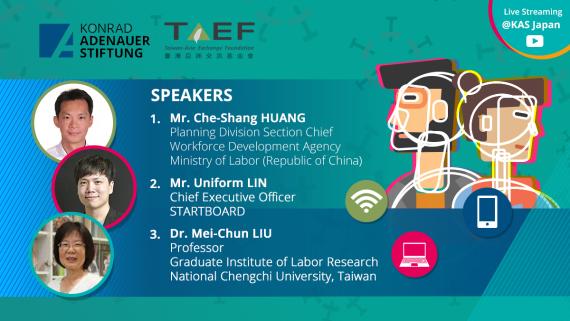
The session was opened by Ms. Rabea Brauer, KAS Country Representative for Japan and SOPAS Director. The panel of speakers was comprised by Mr. Jason Che-Shang HUANG, Planning Division Chief of the Workforce Development Agency, Ministry of Labor (Republic of China); Mr. Uniform LIN, Chief Executive Officer of STARTBOARD; and Dr. Mei-Chun LIU of the Graduate Institute of Labor Research, National Chengchi University. TAEF Executive Director Dr. Alan Hao Yang delivered the summary and closing remarks for the session. Mr. Yuri Baral, TAEF Non-Resident Assistant Research Fellow, served as a moderator for the activity.
Speaker 1: Mr. Jason Che-Shang HUANG, Planning Division Chief, Workforce Development Agency, Ministry of Labor, Taiwan (Republic of China)
Mr. Huang’s talk approached the topic from the perspective of the government and introduced the Ministry of Labor’s Workforce Development Agency (WDA). He spoke on three critical issues: youth employment analysis, challenges of future work and new technology for youth employment, and inter-ministerial collaboration (Youth Employment Investment Program).
In 2019, Taiwan’s youth unemployment rate was 8.7%, with a duration of youth unemployment of 21 weeks. Four phenomena describe Taiwan’s youth employment: First, Taiwan’s youth unemployment is around 2.3 times higher than the overall national unemployment rate. Second, the number of unemployed first job seekers are increasing and have difficulties finding first jobs. Third, older unemployed youth groups might contribute to social problems; and Fourth, the willingness of young generations to take atypical jobs.
The challenges and opportunities of future work for Taiwan echo the global trends in workplaces (e.g, work-from-home arrangements replacing office-based work, increased job opportunities for AI technology, flexible work hours, and increased freelance job opportunities due to the competitive job market). While young workers have digital proficiency advantages, they face the dilemma of choosing between flexibility, independence, and multifaceted jobs versus labor protection, job stability, and traditional full-time job benefits. As the impact of COVID-19 continues to be felt across industries, digital technology is rapidly becoming the new mode of business. Taiwan recognizes the importance of reskilling and upscaling its young workforce in preparation for the future of work.
The Youth Employment Investment Program is an inter-ministerial collaboration effort aimed at enhancing youth employment in Taiwan. The Program targets high school students, first-time job seekers, unemployed youth, employed youth, atypical workers, and more. Aside from conducting extensive surveys to better understand the latest job trends in Taiwan, it provides employment matching services and in-depth career consultations, subsidies for vocational training and internship programs, and financial rewards for enterprises that hire young workers.
For first-time job seekers, the WDA works with Taiwan’s Ministry of Education to gather feedback on current vocational programs and curriculums. For young workers, the Program offers generous subsidies to attend vocational training. It also provides young workers unemployed for six months or more in-depth career consultation with opportunities to participate in paid internship programs. Atypical workers are afforded financial incentives to attend training programs and are assisted in their transition from part-time to full-time work. The WDA is dedicated to creating equal employment benchmarks for enterprises to treat atypical and typical workers alike.
Speaker 2: Mr. Uniform LIN, Chief Executive Officer, STARTBOARD
Mr. Lin addressed how new trends and technology will bring challenges to Taiwan’s younger generations. His presentation highlighted the importance of entrepreneurship in future jobs and identified three types of challenges to overcome: new trends, new technology, and a new mindset.
The new trends in businesses derive from the lazy economy and time-saving services. The lazy economy consists of food and beverage services such as Uber Eats and Food Panda, wherein the scaling of various delivery platforms creates a huge demand for gig workers such as delivery drivers, suggesting that more people are likely to engage in flexible and tech-oriented jobs instead of committing to full-time positions. On a similar vein, convenient time-saving services in elderly home care, errands, deliveries, housekeeping, etc. generate temporary employment opportunities.
The second challenge is new technology. The advent of ‘5G networks’ is expected and beginning to change the fields of healthcare, entertainment, and big data. For the healthcare industry, 5G networking allows for faster data transactions for medical diagnosis, hold virtual meetings, and monitor health conditions with real-time capacity. For the entertainment industry, the higher-speed internet of 5G enables latency-free interactions between performers and their audience. The entertainment industry is also the most likely to employ new devices, technology, and features in aid of their daily operations. As new technology generates massive data, analytical tools become a critical topic for startups. By turning data into information, it can help people and AI to make rational decisions while reducing potential risks and iterating new technology.
The third challenge is a new mindset for shifts in the workforce, legal compliance, and resource integration. As new technologies replace jobs, there will be a shift in the workforce to transform repetitive task jobs into creative jobs. ‘Slashie’ (斜槓) will be the new normal where people can have multiple jobs or means for living. As technology leaps, it is highly expected for social protection to lag behind. Some of the legal compliance issues include unreasonable work hours, lack of protection for personal privacy, discrimination at work, and operation of monopoly companies. For future jobs, resource integration and utilization of information from government, business stakeholders, startup ecosystems, and original market players will be critical. The ease of access to the internet gives an advantage but also a disadvantage for the younger generation in creating unique businesses and increasing efficiency.
In order for younger generations to have a better employment outlook, it is necessary for them to reskill and upskill, keep abreast of new employment trends in their chosen fields or sectors, improve their proficiency on the latest technological innovations, as well as to have a pliant and adaptive approach towards work (and opportunities).
Speaker 3: Dr. Mei-Chu Liu, Professor, Graduate Institute of Labor Research, National Chengchi University, Taiwan
Aside from the government and NGO perspective, in the webinar section, Professor Liu mentioned several labor issues she encountered in the course of her research on jobs and labor policy concerning Taiwan’s young people.
The youth in Taiwan are facing a more difficult and demanding world than the time of their predecessors. The current employment situation is dismal for them as there are much higher unemployment rates, lower wages and more barriers which makes it more challenging for first-time workers.
The unemployment rate for Taiwanese youth ages 15 to 24 is 11%, which is three times higher than the national average. Although the issues of youth unemployment exist in Western countries, the ratio is often only two times. Therefore, youth in Taiwan are facing a higher risk of unemployment and also long-term unemployment. High unemployment rates mean a waste of labor force, which Taiwan cannot afford due to having the lowest birth rate in the world. It impacts the social insurance system—both labor and health insurance.
Having low wages is a social disease that has a negative and lasting impact. Undergraduate students earn less than 30,000 NTD (1,000 USD). This amount is nearly the same as the minimum legal wage which is set for those with lower social capital. These low wages become a barrier for young people in getting married, raising a family, and financing housing expenditure. This highly undermines the sustainability of the future, not only economically but also socially. Should this continue to be the trend, then Taiwan’s young people could easily transition to become NEETs (not in employment, not in education, not in training programs).
It is becoming more difficult for the youth to enter the job market nowadays because the employers favor those with internship experiences and multi-skills. By this practice, internships have become a human source strategy that effectively employs people at lower labor costs, if at all paid. Without viewing such workers as future staff whom employers should invest in (e.g., mentorship/training), employers casually see them as cheap labor that can easily be replaced by others from an unlimited labor pool. This results in a higher turnover rate of youth than their previous counterparts. The young generation were slandered or defiled by media as the “strawberry generation”(草莓族), indicating that they are not strong enough to endure ordinary workload and psychologically vulnerable. However high turnover rate is a signal of their resistance against worsening labor conditions since this is the only tool that individuals have to fight back. On one hand, the percentage of labor unions formed in Taiwan is low. On the other hand, workers are hesitant to pursue collective actions. These factors made the upon situation for workers worse. While the unions are too weak to balance between the workers and the capital power, outsourcing tasks became a method for the corporates to maintain relatively low labor cost.
Due to the challenges faced by the youth, many have lost their aspiration toward the future. It is less likely for an entry-level youth to land a job with decent working conditions and security. While the youth aspires to make a transition, the research however shows that such transition period is prolonged. Besides the quality of work such as reasonable working hours, labor rights, and privacy, the youth also values flexibility of work. In order to pursue more flexibility, the youth tends to be self-employed. The other alternative for the youth is to take national examinations of public officials since they believe they have no future in the private sectors. In recent years, there are increasing numbers of young people who choose to pursue a public domain career, especially graduates from the top universities who are being expected to face more challenges. Moreover, with such frustration in their job prospects, there is no surprise that the talented youth are moving to places that could treasure their talents. Taiwan will face double jeopardy if this continues. While Taiwan is facing its population crisis with a low fertility rate and high aged population, the loss of youth will become a social and economic crisis.
What the government can do first is to stop suppressing the outsourcing workers who work for the government. There are many workers who work for the government that are paid poorly. If the government continues to offer jobs with bad working conditions, they are in no position to persuade employers in private sectors to treat their workers better. In addition, the government has to encourage good practices of corporate social responsibility (CSR) with all means. Business sectors can and should contribute more for the employees’ human capitals and trust. Moreover, the good corporate governance also includes transparency and fairness. Last but not the least, employers have to recognize the importance of unions which can function as a facilitator between employers and workers.
This session concluded with Dr. Alan Hai Yang’s summary of discussion, he also added a question on how Taiwan can contribute to the region.
Before entering his closing remarks, Dr. Alan Hao Yang first readdressed the last question by adding, “How can Taiwan contribute to the region?” The answer to this question is that the willingness to collaborate and be open-minded to work together. During the past decades, Taiwan has been left out in the process of regional integration since 1967 when ASEAN was established. Even with such a situation, in the late 1970s and 1980s, Taiwanese companies, business sectors and also Taiwanese people especially the youth were willing to visit Southeast Asia, not only did they pursue their own career there, but also they tried to be connected with the local business network. This resulted in the first gold south policy launched by the Taiwanese government in the 1990s. In 2016, the Taiwanese government implemented the New South Bound Policy, which shows the bi-directional engagement between both Taiwan and the Southeast Asian Region. Also, as this policy was launched, it invited more talented people from Southeast Asia and also South Asian countries to Taiwan. This can be proved by the expanding community and also the increasing number of the young talent from those countries. It will become a new pattern of co-production and co-cultivation of the young workforce not only in Taiwan but also in the region. For Taiwanese young people, it becomes an opportunity that they can communicate and interact with others in the region. Such opportunities to learn about each other were not available for the elder generation. In order to make Taiwan a part of the region, Taiwanese need to continuously cooperate with Southeast Asians. Therefore, it could be a basis to think of the solutions in future work for the Asian young generation.
Dr. Yang then summarized the discussion of all speakers by dividing them into three main target groups: The Youth, Youth Workers, and the Stakeholders. The term Stakeholders is similar to the concept of an ecosystem, combining with the public sector, private sector, civil society, and also NGOs.
Young people are having high expectations for their future work ideals. These expectations for work are not only materially but also spiritually. They care more about reasonable work hours, the privacy of their working space and also the equality and non-discrimination condition. In the meantime, young people should also be equipped with a new capacity in tackling the new challenge. For example, the AI Artificial Intelligence knowledge of digital skills.
The second target group is young workers who are currently having a job. Their expectation for the future of work is to seek better work experience and environment combined with a better wage condition, welfare, and job safety. They are also facing new types of works and increasing amounts of atypical works. In order to facilitate a better workforce service, the government plays a very important role. While the Taiwanese government had tried hard working on a cross-ministerial collaboration, however, there are still efforts to be made by the government. The government should reconsider its policy to the outsourcing worker within the government system. As for the private sector, in order to provide better service, they need new workers equipped with new trend skills.
As the globe faces the pandemic, we are the so-called “lockdown generation”. The feature of lockdown generation includes the three different F: Freelance, Flexible, and Floating working space, which means you can work from home or you can work at a coffee shop. These 3F dynamics are special features that will be related to the future of work. The government needs to accommodate those new features so that we can re-educate or provide a more feasible training program for the young workforce.
